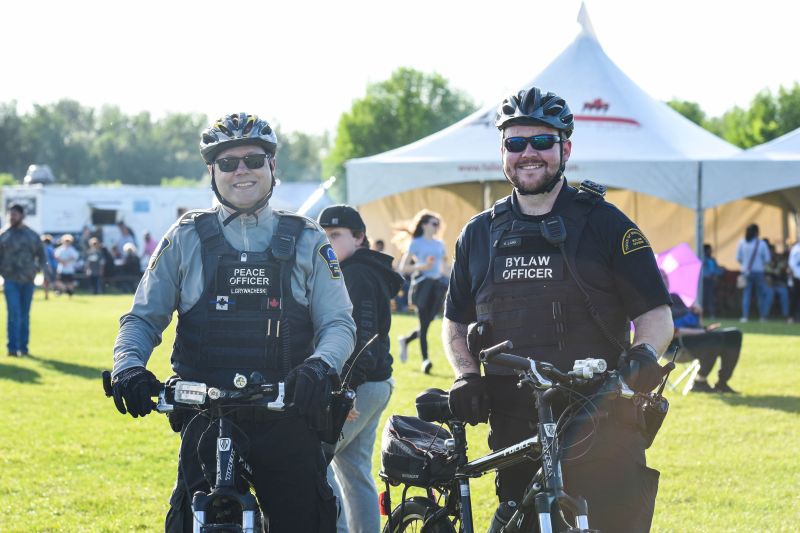Significant changes to the role of Peace Officers in the community follow changes to Policy 23-
005 – Emergency Response Vehicle Operations and the creation of Policy 23-016 – Body Worn
Cameras and In-Car Video Systems. Before the changes, Policy 23-005 limited a Peace
Officer’s use of emergency equipment to traffic control for accidents and road closures, creating
a safe zone in which to work and enforcement of bylaws and certain Provincial Act infractions.
The previous policy stated that Peace Officers could not use emergency equipment
(lights/sirens) to stop a vehicle to enforce the Traffic Safety Act (speeding, stop signs,
crosswalks). The newly updated policy states that Whitecourt’s Peace Officers can now use
emergency equipment for moving and non-moving traffic enforcement.
Changes also include how Peace Officers handle emergency responses. The new policy allows
them to respond to certain approved situations using their lights and sirens. To move up to this
level of response, all Level 1 Community Peace Officers will need to successfully complete a
40-hour emergency vehicle operations course based on police curriculum.
Emergency response situations under the updated policy include injury collisions, fire/medical
calls at the request of Fire/EMS, requests by a Police Service to help with response capacity,
back up for police or other Peace Officers if there is reasonable belief that the officer is in
danger and the Peace Officer is the closest help possible. The policy states, “Having Peace
Officers conduct traffic enforcement is meant to augment existing systems already in place in
order to continue to provide a safe and healthy community.”
The policy also limits response, stating that emergency vehicle response is not to be conducted
in non-injury motor vehicle collisions, non-urgent situations, and backup for police when the
Peace Officer is not the closest option (unless requested). Limits in the original policy, including
using equipment like spike belts or roadblocks, remain unchanged and are not allowed.
Pursuits, specifically, are one area where Peace Officers are not to engage for the safety of
others. The policy states, “Community Peace Officers shall NOT engage in pursuits under any
circumstances. Pursuits may involve high or low speeds and vehicles other than automobiles.” It
states that officers must immediately cease efforts once they determine the driver they are trying
to stop is aware of their attempts to stop them and fails to do so. Instead, they are required to
contact the police and share all pertinent information like make/model, direction of travel, etc.
Another thing they cannot do is a breath test on a suspected impaired driver. Should a Peace
Officer pull over a driver suspected of being impaired, they are to alert the police as impaired
driving is a Criminal Code offence, falling under police jurisdiction.
The Public Security Peace Officer Policy, a provincial document that oversees how the Peace
Officer program is conducted, allows officers to use only specific equipment, including their
vehicle, handcuffs, PPE (stab/bullet-resistant vest, gloves), and dog/bear spray. The same goes
for emergency equipment, like speed detection, animal control devices, traffic cones/flares/first
aid kits, and flashlights.
Lee Hardman, Director of Community Safety for the Town of Whitecourt, oversees the local
Peace Officer program and approves, disallows, or limits the use of specific equipment when
necessary. He explained that Peace Officers would also be trained to do radar detection in the
community, expanding that service. Hardman added that the changes to Policy 23-005 arose
following a Municipal Enforcement Service Level Review earlier this year. He said these
updates are in force in most Peace Officer departments province-wide.
The review also brought up the need for body-worn cameras. Policy 23-016 was created for this
specific topic. “This has become more of the norm in first responders, so we are adapting with
that,” said Hardman. “There are some objectives with those systems, which are reducing the
safety risks to officers working alone, providing additional evidence, augmenting current
notetaking practices, and improving evidence documentation and accuracy of claims.”
He said that if complaints were brought forward against any Whitecourt Community Peace
Officers, the footage obtained by the body-worn cameras would back it up either way. “It also
helps deescalate conflicts when people know they are on video, and it provides greater insight
on service delivery,” he explained during the Monday, May 27 Regular Meeting of Council at the
Forest Interpretive Centre. Town Council learned more about both policies during May’s Policies
and Priorities Committee meeting on May 21 at the Town Office, where the committee
recommended they be approved.
Both the updated Policy 23-005 – Emergency Response Vehicle Operations and brand-new
Policy 23-016 – Body Worn Cameras and In-Car Video Systems were unanimously approved by
Council. Hardman said both policies would be sent to the Peace Officer Program for approval
following their vote. “I do anticipate that we will have approval for this policy as it goes with most
of the policies around the province,” he said. Before Community Peace Officers in Whitecourt
start implementing their expanded service abilities under the new/updated policies, full training
will take place to prepare them for their new duties.








More Stories
Community spirit shines at large-scale youth baseball event
Birthday party chaos sung beautifully by Pumpjack Players’ youth in spring musical
Gearing up for another season of cars, cruising and camaraderie